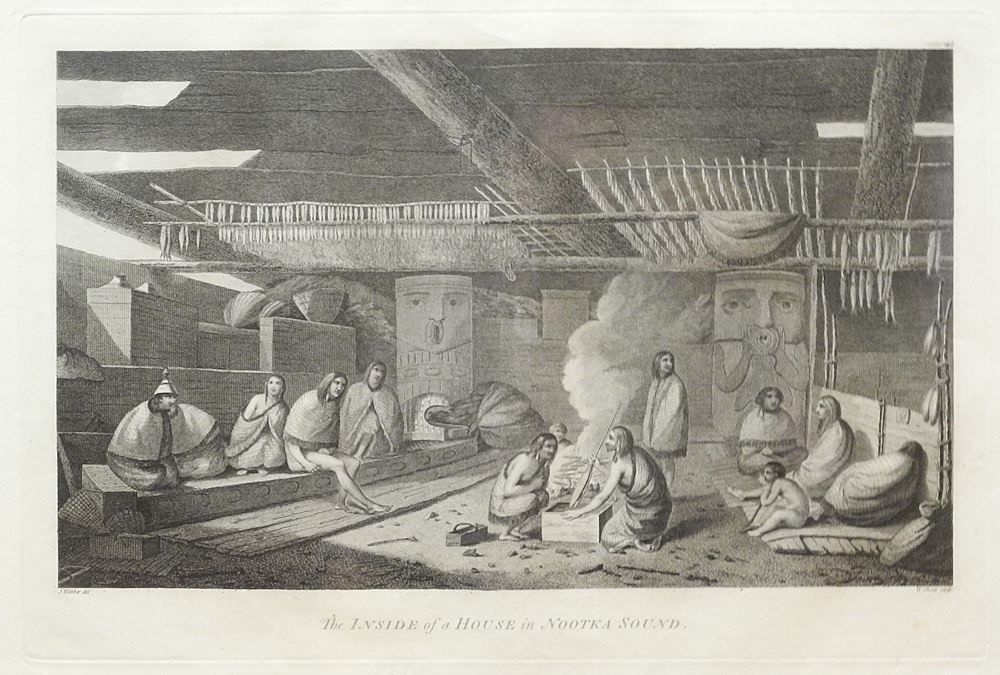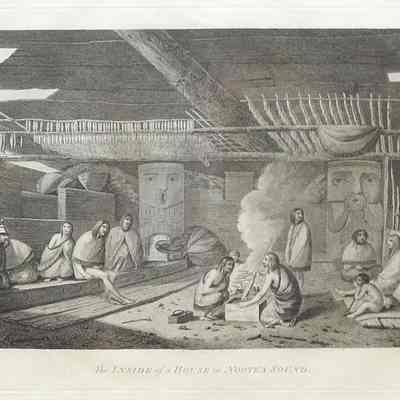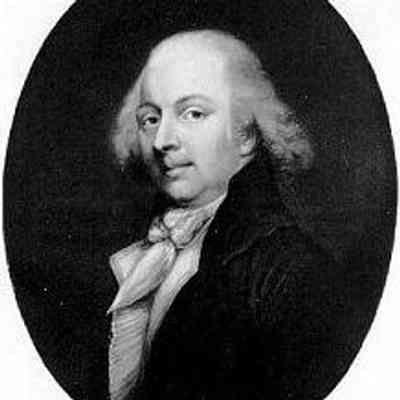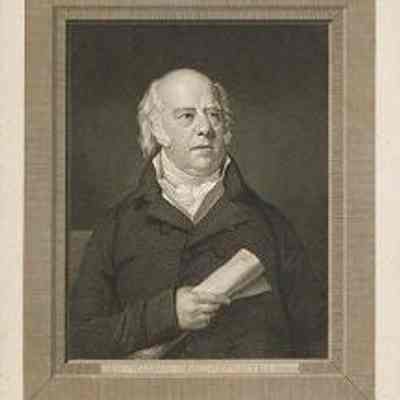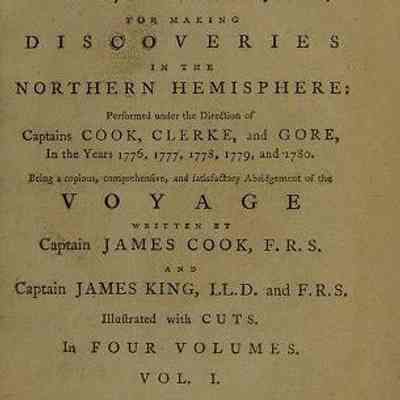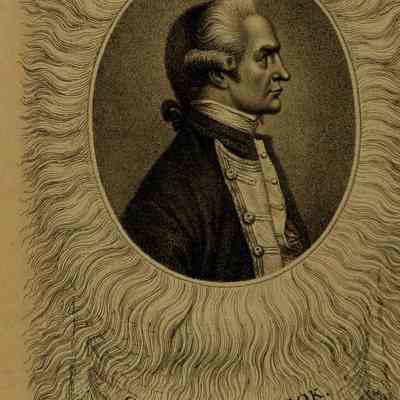Name/Title
The Inside of a House in Nootka SoundEntry/Object ID
2024.12.09Description
Steel engraving illustration 1784 by William Sharp (1749-1824) after 1778 drawing by John Webber (1751-1793).
From Captain James Cook, F.R.S. and Captain James King, LL.D. and F.R.S. 1784. "A Voyage to the Pacific Ocean; Undertaken by Command of his Majesty, for making discoveries in the Northern Hemisphere: Performed under the Direction of Captains Cook, Clerke, and Gore, in the Years 1776, 1777, 1778, 1779, and 1780. Being a copious, comprehensive, and satisfactory Abridgement of the Voyage." London: J. Fielding Paternoster Row. Printed for John Stockdale, Scatcherd and Whitaker, John Fielding, and John Hardy. Vol. II, page 316?, plate 42.
Of note, the publication of Cook’s third voyage was unprecedented in terms of the amount of money spent on the illustrations that accompanied the expedition text. In fact, the priority given to quality artwork set the standard for subsequent publications on voyages of discovery.
______________________
As part of his expedition to explore the coasts of the Pacific Ocean and to determine the possibility of a North-West Passage, Cook traveled to Nootka Sound (King George's Sound) on the north-west coast of Vancouver Island between March 29 and April 26, 1778. Some of Webber's drawings can be dated precisely to April 22 when he accompanied Cook to the village of Yuquot or Nootka on Nootka Island in Nootka Sound. Reportedly, this represents one of the significant and earliest examples of accurate depictions of First Nations peoples, dwellings, culture and scenery. Indeed, Webber's collective works from the entire Pacific voyage was the most comprehensive record of sights in the Pacific region ever produced.
This image is an interior scene of a house in Nootka. A stone boiling box with a man working on either side is a focal point of the image. Stem/smoke is rising upwards and a large number of salmon, likely smoked, are suspended from poles on the roof ceiling. There are various openings in the roof for the entry of light, fresh air and the escape of fire smoke. A dozen First Nations individuals in traditional clothing are shown doing various activities such as cooking and weaving with some seated on raised mats or benches. Two large carved wooden "supreme being" sculptures are placed at the back in front of and to the side of various raised platforms with wooden cooking and storage boxes and baskets.
Cook reportedly and rightly assumed that these houses were used on a temporary basis as the Nootka people changed locations with the availability of seasonal marine and land resources such as fish, whales, berries, bark, etc. Removable planks fixed to permanent frames formed these large pre-fabricated multi-generational or multi-family houses. These same planks were used to transport belongings and were then re-used to make new houses at the new location.Artwork Details
Medium
Engraving on paperSubject Place
Region
Pacific NorthwestContinent
North AmericaContext
Yuquot or Nootka is located on Nootka Island in Nootka Sound, just west of Vancouver Island, B.C. It was the summer home of Chief Maquinna (fl. 1778-95) and the Mowachaht/Muchalaht (Nuu-chah-nulth) people for generations, with some 1,500 people in 20 traditional wooden longhouses. The name means "Wind comes from all directions" in Nuuchahnulth.
The Nuuchahnulth, formerly referred to as the Nootka, Nutka, Aht or Tahkaht, are one of the First Nations peoples of the Pacific Northwest Coast in Canada. The term Nuuchahnulth, meaning " all along the mountains and sea" and used as a collective term of identification, was chosen in 1979 by the thirteen tribes whose traditional home is the western coast of Vancouver Island, B.C. The Makah of northwest Washington are also Nuuchahnulth.
- Plaque(s) from Parks Canada: Yuquot National Historic Site of Canada
Yuquot, Nootka Island, British Columbia
Discovered by Captain James Cook, in March 1778. In June, 1789, Spain took possession and established and maintained a settlement until 1795. The capture of British vessels, in 1789, almost led to war, which was avoided by the Nootka Convention 1790. Vancouver and Quadra met here, in August, 1792, to determine the land to be restored under that convention.
To the Mowachaht-Muchalaht First Nations, Yuquot has always been the centre of their social, political and economic world. Whaling was a vital part of the life of the Mowachaht-Muchalaht, and of all the Nuu-chah-nulth peoples. Near here once stood the Whalers Washing House, a unique ceremonial structure and the most significant monument to a purification ritual on the West Coast of North America. In the late 18th century, Yuquot became an important site of early contact between First Peoples and Europeans. Explorers and traders were attracted to this safe harbour, which they called Friendly Cove. As a result, Yuquot, also known as Nootka, developed into an important centre of trade and diplomacy, and it was briefly the site of Spain's only military establishment in present-day Canada. Yuquot became the focal point of the Nootka Sound Controversy of 1789-1794, when the rival interests of Great Britain and Spain brought those countries to the brink of war.Made/Created
Artist Information
Artist
John Webber, RA (1751-1793)Role
ArtistArtist
William Sharp (1749-1824)Role
EngraverArtist
J. Fielding, LondonRole
PublisherArtist
Captain James Cook, FRS (1728-1779)Role
AuthorArtist
Captain James King, LLD, FRS (1750-1784)Role
AuthorDate made
1784Time Period
18th CenturyNotes
ARTIST etc. BIOGRAPHIES
- John Webber
Born in London, son of the Swiss sculptor Abraham Wäber, John Webber was the official artist on Captain James Cook’s third voyage of 1776-80 aboard HMS Resolution, best known for his images of Australia, Tasmania, New Zealand, the Sandwich Islands (now Hawaii), Alaska and notably Nootka Sound on Vancouver Island where Cook’s ships had anchored to refit.
Webber trained in Berne with the landscape and portrait painter and etcher Johann Ludwig Aberli (1723-1786), and then from 1770 studied in Paris under the engraver Johann Georg Wille (1715-1808) at the Académie Royale. He entered the Royal Academy Schools in London and exhibited there in 1776. His work impressed the botanist Dr. Daniel Carl Solander, assistant to the naturalist Joseph Banks who recommended his employment on Cook’s voyage.
After returning to England in 1780, Webber was responsible for reducing his drawings and paintings to scale for engravers for the British Admiralty's account of the Cook expedition which was published in 1784. The Admiralty also commissioned him to supervise the engravers and the printing of the plates. Webber also exhibited around 50 works at Royal Academy exhibitions from 1784 to 1792, and he was elected an associate of the Royal Academy in 1785 and a full member in 1791. He also printed a series of his own etchings of the voyage; unfortunately however, he died at age 41, of a kidney disease in London.
Of note, Webber’s depictions of Nootka Sound, estimated to be 29 extant, show close to 20 different subjects of the coast. The most important drawings, those of Nootka First Nations, the inside and outside of their houses, their masks and more, are considered to be of incalculable ethnological value.
- William Sharp
Born in London, William Sharp was one of England's most accomplished engravers of the late 18th century. Sharp began his career as an engraver of pewter pots and tankards. From 1771, he studied at the Royal Academy schools, after which he set himself up as a line engraver. One of the 18th century's most accomplished line engravers, Sharp excelled at portraits and allegorical and historical scenes, creating larger plates and he came to be seen as a key figure in the revival of the classical style of line engraving. He went on to contribute to many of the most important serial publications of the day.
Sharp became an honorary member of the Imperial Academy in Vienna and the Royal Academy in Munich disdaining the offer of membership to the Royal Academy because of their view that engraving was an inferior form of art, meriting a lesser type of membership.
- J. (John) Fielding (Also known as Fielding & Walker)
Printer and publisher, 23 Paternoster Row, London, England
???FIELDING, Sir John. 1775/1800. Bookseller. 20, Paternoster Row 1776; 23, Paternoster Row 1781L-1786. Free Musician's Co. 2 May 1776. Publ. The plan 1774-80, London courant 1781, European magazine 1782-84. Musical imprints 1782-85. Bankrupt 1783, cert. 20 Mar. 1784, bankrupt again 17 Mar. 1787, divs. 23 June 1787, 13 June 1789, 25 May 1796, 9 July 1796. See also Fielding and Walker. Imprint(s): Kress: 1782: B476, 481-82; 1786: B1025, 1049. Brown; Humphries and Smith; Darlington and Howgego; Werkmeister; Aspinall; BM Satires 1781-85.
https://bookhistory.blogspot.com/2007/01/london-1775-1800-f.html
- Captain James Cook
Captain James Cook was a British explorer, cartographer and naval officer famous for his three voyages (between 1768 and 1779) to the Pacific Ocean (with the ships Endeavour, Resolution, Adventure, and Discovery) and did more than any other voyager to explore the Pacific and Southern Oceans where he encountered Pacific cultures for the first time. He was killed in an altercation with islanders in Hawaii when tensions arose in 1779; however, the islanders did esteem Cook and they prepared his remains as per funeral rituals usually reserved for chiefs and highest elders of their society.
Recent controversies over public representations of Cook and the display of Indigenous artifacts from his voyages are part of the broader debate over colonialist narratives. Some see Cook as an enabler of Imperialism and others defend his "enlightened" attitudes of the time.
- Captain James King
Captain James King was an officer of the British Royal Navy, serving under James Cook on his last voyage around the world. He specialized in taking important astronomical readings using a sextant. After Cook died in Hawaii he helped lead the ships on the remainder of their course, and he also completed Cook's account of the voyage.Inscription/Signature/Marks
Type
Title, InscriptionLocation
Printed in plate:
Lower left: J. Webber del.
Lower centre: The INSIDE of a HOUSE in NOOTKA SOUND
Lower right: W. Sharp. sculp.
Upper right: 42Dimensions
Dimension Description
VisibleHeight
29.2 cmDimension Description
Plate markHeight
27 cmWidth
40.3 cmAcquisition
Acquisition Method
PurchaseDate
Sep 10, 2024Notes
Lunds Lot #222Relationships
Related Entries
Notes
2018.02.02 Friday Evening (…1788, the FELICE…harbor (TOFINO), Cpt. JOHN MEARES & CHIEF WICKANINNISH on deck…Copyright
Notes
Images are provided for research and reference use only. Permission to publish, copy, or otherwise use these images must be obtained from the copyright holder. It is the sole responsibility of the applicant to determine the copyright holder and to obtain permission(s) as needed.